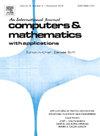Collocation-based numerical simulation of multi-dimensional nonlinear time-fractional Schrödinger equations
IF 2.9
2区 数学
Q1 MATHEMATICS, APPLIED
引用次数: 0
Abstract
This paper introduces meshless and high-precision barycentric interpolation collocation methods, grounded in two well-established difference formulas, for solving the nonlinear time-fractional Schrödinger equation. This equation is characterized by complexity arising from power-law nonlinearity and multi-scale time dependence. To enhance spatial accuracy, we utilize two meshless barycentric interpolation collocation methods that exhibit exponential convergence in the spatial domain. After discretizing the spatial variables, we discretize the Caputo derivative using both the classical L1 formula and a related fast algorithm that incorporates the sum-of-exponentials technique. The nonlinear term is addressed through an explicit scheme augmented with a second-order stabilization term. Consequently, we derive fully discrete schemes capable of numerically solving the equation. Furthermore, we undertake comprehensive consistency analyses of the semi-discretized schemes in the spatial dimension, along with analyses of the nonlinear fully discretized schemes, leveraging the approximation properties of the collocation methods. Our numerical simulations, encompassing one, two, and three dimensions, conclusively demonstrate the remarkable accuracy and efficiency of the proposed collocation methods. Moreover, by comparing the error with that of a traditional finite difference method, we showcase that our schemes offer superior accuracy while requiring fewer nodes, thereby emphasizing their advantageous characteristics.
求助全文
约1分钟内获得全文
求助全文
来源期刊

Computers & Mathematics with Applications
工程技术-计算机:跨学科应用
CiteScore
5.10
自引率
10.30%
发文量
396
审稿时长
9.9 weeks
期刊介绍:
Computers & Mathematics with Applications provides a medium of exchange for those engaged in fields contributing to building successful simulations for science and engineering using Partial Differential Equations (PDEs).
 求助内容:
求助内容: 应助结果提醒方式:
应助结果提醒方式:


